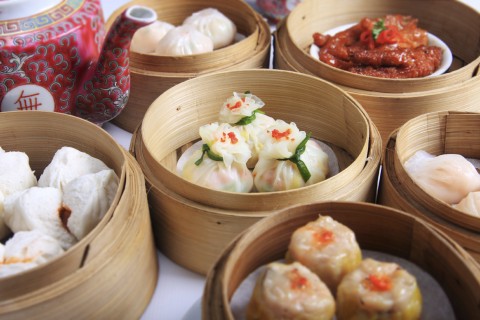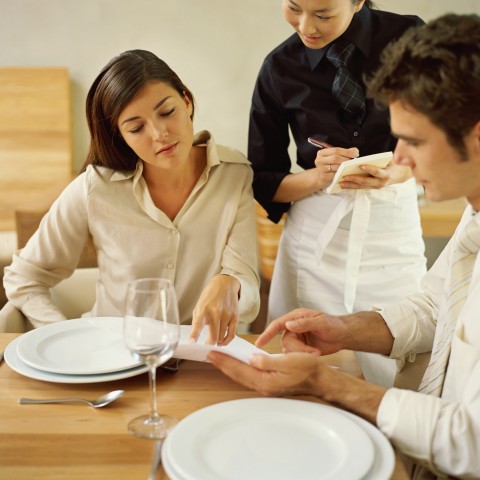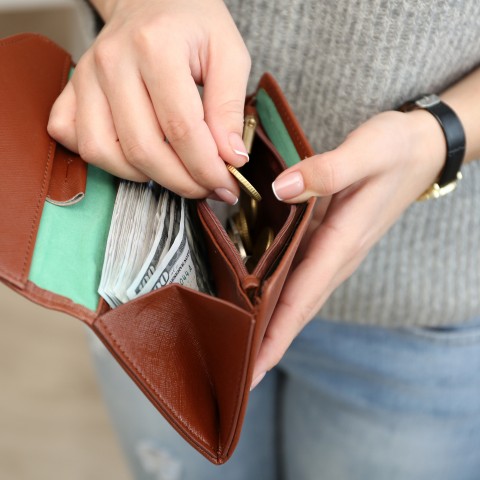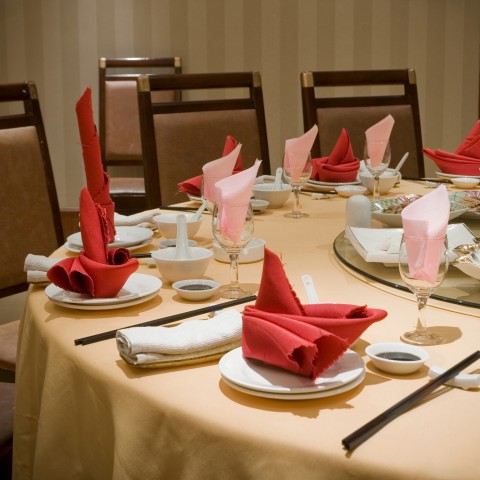
Hong Kong is a food paradise! Not only does it have the highest density of restaurants in the world, but there is also a great variety of local dishes and mouth-watering delicacies worth trying. On top of the famous dim sum, there are other Cantonese foods, such as egg tarts and fish balls, that are too good to be missed.

There’s a saying in Cantonese that reveals how much we care about food:
- 民以食為天 (man4 ji5 sik6 wai4 tin1) – “Food is god to people.”
Indeed, food is one of the most important aspects of life: it brings you energy and joy, and you need it every single day. To ensure that you won’t miss out on the great food in Hong Kong, we have compiled a list of Cantonese phrases for you to navigate through the local restaurants!
 Table of Contents
Table of Contents
- Before Dining
- During Dining
- After Dining
- Bonus: Dining etiquette in Hong Kong
- How CantoneseClass101.com Can Help You Learn More Cantonese
1. Before Dining

There are lots of varieties of restaurants in Hong Kong – some require advanced bookings, and some do not. Most local inexpensive restaurants do not require advanced bookings, and you can just walk in. On the contrary, most fine dining restaurants require making reservations in advance, and sometimes you have to wait for months before you can secure a table. I strongly recommend the app OpenRice if you need to look up information about restaurants in Hong Kong. This powerful app allows you to search restaurants based on location and types of cuisines. You can view customers’ feedback as well as reserve a table through the app.
A- Reserving a table: conversation
Customer-
Chinese Character: 唔該, 我想訂枱。
Romanization: m4 goi1, ngo5 soeng2 deng6 toi2.
Meaning: Excuse me, I want to book a table.
Restaurant staff-
Chinese Character: 幾點?
Romanization: gei2 dim2?
Meaning: What time?
Customer-
Chinese Character: 八點, 唔該。
Romanization: baat3 dim2, m4 goi1.
Meaning: Eight o’clock, thank you.
Note: To say a time, state the hour followed by “點” (dim2), which means “o’clock.”
Restaurant staff-
Chinese Character: 幾多位?
Romanization: gei2 do1 wai2?
Meaning: Eight o’clock, thank you.
Customer-
Chinese Character: 四位。
Romanization: sei3 wai2.
Meaning: Four people.
Note: To respond to the above question, you can state the total number followed by the measure word for “people”, which is “位” (wai2). There is another measure word for people that is “個” (go3), but “位” (wai2) is more polite.
Cantonese number from 1 to 10 for people and time:
- 0: 零 (ling4)
- 1: 一 (jat1)
- 2: 兩 (loeng5)**
- 3: 三 (saam1)
- 4: 四 (sei3)
- 5: 五 (ng5)
- 6: 六 (luk6)
- 7: 七 (cat1)
- 8: 八 (baat3)
- 9: 九 (gau2)
- 10: 十 (sap6)
** There are two ways to express “2” in Cantonese, “兩”(loeng5) should be used in describing people and time.
B- Other relevant phrases
Chinese Character: 唔該, 我想訂枱,八點,四位。
Romanization: m4 goi1, ngo5 soeng2 deng6 toi2, baat3 dim2, sei3 wai2.
Meaning: Excuse me, I want to book a table at eight o’clock for four people.
Chinese Character: 唔該, 有冇位呀?
Romanization: m4 goi1, jau5 mou5 wai2 aa3?
Meaning: Do you have a table?
Chinese Character: 要等幾耐?
Romanization: jiu3 dang2 gei2 noi6?
Meaning: How long do we have to wait?
- ➜ To learn more about Cantonese numbers, visit our blog that covers Cantonese Numbers from 1-100 and Beyond!
2. During Dining

Here’re some useful phrases inside a restaurant in case you need help communicating with waiters and waitresses.
A- Asking for menu and recommendations
Chinese Character: 唔該俾張餐牌我睇。
Romanization: m4 goi1 bei2 zoeng1 caan1 paai4 ngo5 tai2.
Meaning: Please, can I have the menu?
Chinese Character: 你有乜嘢推介?
Romanization: nei5 jau5 mat1 je5 teoi1 gaai3?
Meaning: What do you recommend?
Chinese Character: 呢度有乜嘢食出名呀?
Romanization: ni1 dou6 jau5 mat1 je5 sik6 ceot1 ming2 aa3?
Meaning: What’s your house specialty?
Chinese Character: 呢碟餸叫咩名?
Romanization: ne1 dip6 sung3 giu3 me1 meng2?
Meaning: What’s the name of this dish?
B- Ordering drinks: conversation
Waiter/Waitress-
Chinese Character: 想飲啲咩呀?
Romanization: soeng2 jam2 di1 me1 aa3?
Meaning: What do you want for drinks?
Customer-
Chinese Character: 我想飲咖啡。
Romanization: ngo5 soeng2 jam2 gaa3 fe1.
Meaning: I would like a coffee.
Note: You can replace “咖啡” (meaning: coffee; romanization: gaa3 fe1) with the beverages you desire.
C- Ordering food
Chinese Character: 今日嘅湯係咩?
Romanization: gam1 jat6 ge3 tong1 hai6 me1?
Meaning: What is the soup of the day?
Chinese Character: 你哋有冇糯米雞?
Romanization: nei5 dei2 jau5 mou5 lo6 mai5 gai1?
Meaning: Do you have any steamed glutinous rice with chicken?
Note: You may replace “糯米雞” (lo6 mai5 gai1) with the name of whatever food you want to inquire about.
Chinese Character: 我想要多士。
Romanization: ngo5 soeng2 jiu3 do1 si2.
Meaning: I want a toast.
Note: You may replace “多士” (do1 si2) with the name of whatever food you want.
Examples of food that you can replace “糯米雞” (lo6 mai5 gai1) and “多士” (do1 si2) with include:
- Pineapple bun: 菠蘿包 (bo1 lo4 baau1)
- Green onion pancake: 蔥油餅 (cung1 jau4 beng2)
- Soup dumpling: 小籠包 (siu2 lung4 baau1)
- Sweet and sour pork: 咕嚕肉 (gu1 lou1 juk6)
- ➜ To learn more vocabulary about Hong Kong food, check out our lists on Hong Kong food and restaurant vocabulary!
Chinese Character: 我食素。
Romanization: ngo5 sik6 sou3.
Meaning: I’m a vegetarian.
Chinese Character: 我對堅果敏感。
Romanization: ngo5 deoi3 gin1 gwo2 man5 gam2.
Meaning: I am allergic to nuts.
Chinese Character: 唔該,我可唔可以要多份?
Romanization: m4 goi1, ngo5 ho2 m4 ho2 ji5 jiu3 do1 fan6?
Meaning: Can I get one more serving, please?
Chinese Character: 你哋有冇甜品?
Romanization: nei5 dei2 jau5 mou5 tim4 ban2?
Meaning: Do you have any desserts?
D- Other relevant phrases
Chinese Character: 洗手間喺邊呀?
Romanization: sai2 sau2 gaan1 hai2 bin1 aa3?
Meaning: Where’s the washroom?
Chinese Character: 唔該, 呢度可唔可以食煙?
Romanization: m4 goi1 ni1 dou6 ho2 m4 ho2 ji5 sik6 jin1?
Meaning: Excuse me, is smoking allowed here?
Note: There are two replies to this question on whether or not you can smoke. The affirmative answer is “可以” (ho2 ji5). The negative answer is “唔可以” (m4 ho2 ji5).
3. After Dining

Check out the below phrases to end your meal happily and elegantly with Cantonese.
A- Check please: conversation
Customer-
Chinese Character: 唔該埋單。
Romanization: m4 goi1 maai4 daan1.
Meaning: Check, please.
Waiter/Waitress-
Chinese Character: 現金定碌咭呀?
Romanization: jin6 gam1 ding6 luk1 kaat1 aa3?
Meaning: Cash or card?
Customer-
Chinese Character: 現金。
Romanization: jin6 gam1.
Meaning: Cash.
B- Other relevant phrases
Chinese Character: 收唔收信用卡?
Romanization: sau1 m4 sau1 seon3 jung6 kaat1?
Meaning: Do you take credit cards?
Chinese Character: 去邊度埋單呀?
Romanization: heoi3 bin1 dou6 maai4 daan1 aa3?
Meaning: Where can I pay the bill?
Chinese Character: 找錯錢呀!
Romanization: zaau2 co3 cin2 aa3!
Meaning: The change is wrong!
Chinese Character: 唔駛找喇!
Romanization: m4 sai2 zaau2 laa3!
Meaning: Keep the change.
4. Bonus: Dining etiquette in Hong Kong

If you’re going to dine at a traditional Chinese restaurant in Hong Kong, tables will typically be large and round to accommodate a group of friends or family. Most dishes are shared instead of à la carte, and they’re placed in the center of the table where everyone gets to take a portion of the dishes.
A- General Food Manners & Restaurant Etiquette in Hong Kong
- DON’T put your hand below or above someone else’s hand while taking the food from a serving plate.
DO wait until the other person finishes grabbing his or her food before you start taking yours.
- DON’T take food from the serving plates and put it into your mouth directly.
DO put it into your bowl first before you eat.
- If you like only a part of the dish, DON’T look for your favorite part on the serving plate.
DO this only while it’s in your bowl.
- DO leave bits of food on your plate to show that you were satisfied.
DON’T leave your plate empty because the host may think you didn’t have enough food.
- DON’T spin your table counterclockwise; always spin it clockwise.
B- Chopsticks
- DON’T point at someone or something with your chopsticks.
- DON’T use your own chopsticks to grab food from the serving plate.
DO use “public chopsticks” (chopsticks that are placed at the center of the table for grabbing the food).
- DO place your chopsticks on the rest provided if you’re not using them.
- DON’T shake your chopsticks if they’re wet from soup.
- DON’T place your chopsticks across each other.
- DON’T put your chopsticks in your rice bowl in an upright position; this is only done at funerals.
C- Tea
- DO open the lid of the teapot or place the lid upside-down if you would like to request more tea.
- DO tap your fingers several times by your cup to thank a person for pouring tea for you.
- DON’T take the first sip; wait for the senior host to do so first.
5. How CantoneseClass101.com Can Help You Learn More Cantonese
After mastering Cantonese phrases to navigate Hong Kong restaurants, do you want to put more Cantonese phrases for other occasions into your pocket? With CantoneseClass101.com, you can have your daily dose of Cantonese whenever and wherever you want through mobile apps, desktop software, and our website. We offer entertaining, engaging, and effective lessons on various aspects of the Cantonese language and culture.
Until now, we’ve delivered more than 750,000,000 lessons to thousands of happy students from all around the globe. You can learn Cantonese with over 1060 audio and video lessons delivered by our knowledgeable and energetic hosts, detailed PDF lesson notes, an abundance of vocabulary learning tools, spaced repetition flashcards, and a lively community where you can discuss the lessons with fellow learners. What are you waiting for? Download our lessons, enjoy our audio and video files, and start learning now!
And keep in mind that if you prefer a 1-on-1 learning approach and want to further accelerate your Cantonese learning, you can take advantage of our MyTeacher program!
Know that your hard work will pay off, and before you know it, you’ll be speaking Cantonese like a native!









